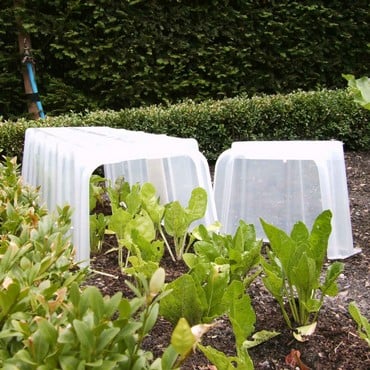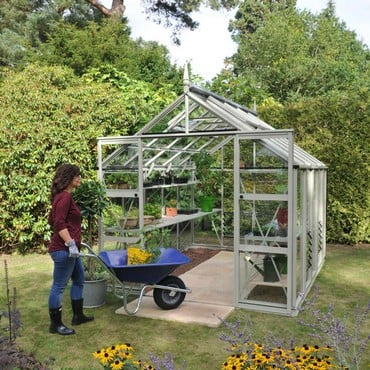 Spring has finally sprung in Stephanie’s Kitchen Garden. As I write this the sun is shining and the sowing season has begun in earnest. Whilst frosty weather still threatens, the days are getting longer and the darkest days of winter seem to be behind us.
Spring has finally sprung in Stephanie’s Kitchen Garden. As I write this the sun is shining and the sowing season has begun in earnest. Whilst frosty weather still threatens, the days are getting longer and the darkest days of winter seem to be behind us.
At the start of February, Jo sowed tomatoes, aubergines, peppers, chillies, celery and celeriac in the heated propagator in the greenhouse. These quickly germinated and at the end of February we spent a happy couple of hours pricking them out into larger pots. This is my favourite job of the gardening year – a warm, sunny greenhouse, a radio and seedlings to be pricked is a recipe for a very happy gardener.
Later in the month we also sowed sprouts, broccoli, spinach and salad leaves in our unheated greenhouse propagator. Outside, we have sown beetroot in a raised bed under a cloche and leeks in our seed bed. Parsnips have also been sown. These take a few weeks to germinate so it’s a good idea to label them so you don’t forget where they are. We have moved our shallots and broad beans from the cold propagator into the cold frame. These have been growing well in the cold part of the greenhouse and will now be hardened off for a couple of weeks before being planted outside.
Earlier in the month we gave our rhubarb patch some care and attention. Last year at this time we divided some of our existing  plants to extend our crop and these grew well throughout the year putting on plenty of growth. At this time of year, the plants benefit from a generous mulch of well rotted manure or garden compost. Our plants were already showing plump buds emerging from the soil and this helped us to avoid mulching over the crowns of the plants which can cause them to rot. We then applied a general purpose organic fertiliser to give the plants a boost. Finally, we chose a couple of well established older plants for forcing. We placed rhubarb forcers over the top of these and they will be checked on a regular basis for sweet pink shoots.
plants to extend our crop and these grew well throughout the year putting on plenty of growth. At this time of year, the plants benefit from a generous mulch of well rotted manure or garden compost. Our plants were already showing plump buds emerging from the soil and this helped us to avoid mulching over the crowns of the plants which can cause them to rot. We then applied a general purpose organic fertiliser to give the plants a boost. Finally, we chose a couple of well established older plants for forcing. We placed rhubarb forcers over the top of these and they will be checked on a regular basis for sweet pink shoots.
 We have also been applying potash to our fruit bushes this month to provide them with potassium to encourage healthy growth and larger fruits. We use the ash from a wood burner in the house, but sulphate of potash will provide the same benefits. Potash has also been applied to our garlic crop this month as it can help protect the plants from rust later in the season.
We have also been applying potash to our fruit bushes this month to provide them with potassium to encourage healthy growth and larger fruits. We use the ash from a wood burner in the house, but sulphate of potash will provide the same benefits. Potash has also been applied to our garlic crop this month as it can help protect the plants from rust later in the season.
Our overwintering broccoli crop is now over and we have been clearing these plants and removing the vegetable cage. The insect mesh cover has been cleaned in hot soapy water and the cage moved to the bed where our brassicas will grow this year. The ground has already been manured and this month we applied lime to the soil to ensure the soil PH is perfect for the crops. Brassicas like a firm soil so it s a good idea to prepare the ground well in advance to allow it to settle before planting.
Our herb pots have all been given a mulch of compost this month too smarten them up and give them a boost for the new season. Jo has divided the mint plants and repotted them. This need to be done every year to reinvigorate the plants. Our asparagus has been given a feed with fish, blood and bone and mulched with strulch.
We are currently suffering from a problem with hungry mice in Stephanie’s Kitchen Garden. Lack of food elsewhere seems to be driving them in our direction. The bird food supply has been sealed in mouse proof containers in the potting shed and crops outside are being covered with chicken wire or cloches to protect them. We are also setting mouse traps to try and relocate the little pests elsewhere before the planting season begins in earnest. One little fellow seems to have taken a liking to our potting shed over the winter and regularly sneaks in for a visit. Having tried to tempt him into a humane trap with various treats, we finally caught him this morning after using peanut butter as bait. He has now been relocated far away from the kitchen garden in the hope that he won’t find his way back!
Here are some of the jobs we've got planned for March in Stephanie's Kitchen Garden:
- Begin applying Nemaslug at the end of the month when the temperatures rise. This will need to be repeated throughout the season.
- Sow Beetrot, summer cabbage, peas, cucumbers, chard, kale and spinach.
- Begin spraying fruit trees with Epsom salts as soon as the foliage begins to emerge.
- Plant out shallots and broad beans.
- Plant out new potatoes at the end of the month.
We're always here to offer advice and support. Go to the Ask the Expert section on the website and Email Horticultural Advisor Jo Blackwell with your Kitchen Garden queries or Pest Control expert Gavin Hatt and they'll do their best to help!
We're busy tweeting about all things Harrod Horticultural - what we're doing, special offers, gardening tips and advice and you can always use Twitter or Facebook to get in touch with us as well. With our web team manning the Tweet decks and Facebook site, you can be sure you'll get the best service we can offer!
Our 100-page Spring catalogue is out now and it's packed full of gardening ideas and products to solve the problems every gardener faces, plus plenty more seasonal ideas for harvesting, storage and preserving solutions.
Happy gardening!





























